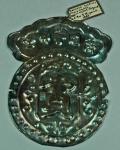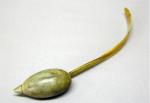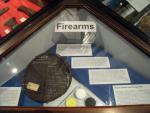The first weapon is what I believe collectors term a 'Wahhabi jambiya' a type of jambiya originating in the Asir, Hejaz, Nejd (generally the South, West and Central Saudi Arabia and Yemen border) and so-called after its use by the followers of Muhammed ibn Abdul Wahhab from the C18th onwards. Locally they are known by vernacular names ('sabak', 'sabiaki', etc). Seen some go for sale in internet for 450 USD and upwards, depending on age and quality.
The second dagger is a Moroccan koummya. These weapons are interesting in that aspects of their design are intended to ward off the evil eye. The curved blade imitates the curved boar's tusk, an animal that responds aggressively if threatened. The commonly seen fretwork on the scabbard is often made so that it creates eye-like gaps and crosses with five points, corresponding the five fingers on the protective Hand of Fatimah. The belt holes look very 'fresh' which suggests the dagger has not been well used. On historical examples, these holes are often worn quite large and uneven by the baldric. As Mervyn pointed out, the blade does not seem in as good shape as the first example. Also, is the scabbard fully decorated on one side or both? If both, it is more likely to be a later, 'souvenir' item as many authentic koummya scabbards were only fully decorated on the side 'on show' to the world when the weapon was sheathed at the hip.
Sword Forum International (www.swordforum.com) are bound to have a thread or two on these types of weapons so might be worth checking that out. Plenty of info on koummyas on the web. For Arabian weapons, try Robert Elgood's very good book 'Arms and Armour of Arabia in the C18th-20th' - if you don't want to buy it, you can probably read snippets via keyword searches on Google books. May not help you with valuations but will give you some historical background if you desire it.
Helen








